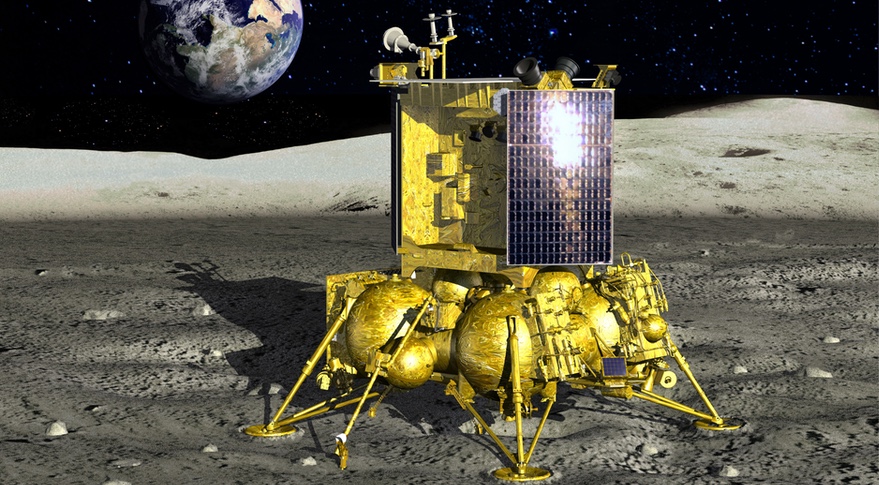WASHINGTON — The European Space Agency announced April 13 it was further cutting ties with Russia by dropping plans to cooperate on a series of lunar missions, turning instead to NASA and other agencies.
At the conclusion of an ESA Council meeting, the agency said it was ending plans to cooperate with Roscosmos on that agency’s Luna-25 and Luna-27 landers and the Luna-26 orbiter. The announcement came nearly a month after ESA formally suspended cooperation with Russia on the ExoMars mission, postponing a launch of an ESA-built rover that had been scheduled for September.
“As with ExoMars, the Russian aggression against Ukraine and the resulting sanctions put in place represent a fundamental change of circumstances and make it impossible for ESA to implement the planned lunar cooperation,” ESA said in a statement.
The long-delayed Luna-25 lander, projected to launch later this year, was to carry an experimental navigation camera called PILOT-D that would collect images during the spacecraft’s landing to support ESA’s work developing a precision landing system for the European Large Logistic Lander (EL3), a proposed lander for delivering large cargoes to the lunar surface.
PILOT-D was already mounted on Luna-25, Josef Aschbacher, ESA director general, said at a press briefing after the meeting. “I have already communicated this decision to the head of Roscosmos and also to request this instrument be put into safe storage until it can be returned to ESA,” he said.
Luna-27, slated for launch later this decade, was to carry Prospect, a payload consisting of a drill and an instrument to study lunar volatiles. Instead, Aschbacher said ESA reached an agreement with NASA to fly the payload on a commercial lander through NASA’s Commercial Lunar Payload Services (CLPS) program.
David Parker, director of human and robotic exploration at ESA, said Prospect would likely fly on a CLPS lander in 2025, although it had not been assigned to a specific mission. NASA’s seven CLPS awards announced to date cover missions scheduled for launch through 2024.
A version of the mass spectrometer instrument on Prospect will also fly on one of the first CLPS missions, Astrobotic Technology’s Peregrine lander, scheduled for launch late this year on the inaugural flight of ULA’s Vulcan Centaur. ESA will fly another version of the instrument on a joint Indian-Japanese lunar rover mission called LUPEX under an agreement between ESA and the Japanese space agency JAXA signed April 4 during the 37th Space Symposium. That mission is scheduled for no earlier than 2024.
Luna-27 was also going to carry PILOT, a full-fledged version of the precision landing technology. “We need to find a suitable flight opportunity for that,” Parker said, which could be augmented with additional ground testing to mature the technology for use on EL3.
New programs, and hope for Sentinel-1B
In addition to the decision to end cooperation with Russia on the lunar missions, Aschbacher used the briefing to announce support for three new initiatives that will be part of the package ESA will present to member states for funding at the next ministerial meeting late this year.
One is Moonlight, a program to develop a satellite system to provide communications and navigation services around the moon. ESA awarded study contracts in May 2021 to teams led by Surrey Satellite Technology Ltd. and Telespazio to examine the technical feasibility of their concepts as well as the business case. Those studies were designed to conclude in time to support a decision on proceeding with Moonlight at the 2022 ministerial meeting.
A second, called Civil Security from Space, will examine how space can support civil security needs. “It focuses mostly on the Earth observation and telecommunications aspects of space, obviously in combination with navigation where appropriate,” Aschabacher said. One example he gave was using space data to support agricultural studies and damage assessments in Ukraine.
The third is Scale-up, which he described as supporting ESA commercialization initiatives but about which he did not go into details. Commercialization is one of the priorities of Agenda 2025, Aschbacher’s overall strategy for ESA released a year ago.
The briefing also provided a glimmer of hope for Sentinel-1B, the radar imaging satellite that has been out of service since last December when the power supply for its radar payload malfunctioned. Engineers have spent months working to diagnose the problem in the hopes of being able to return it to service while ESA also makes plans to launch a replacement, Sentinel-1C, in the first half of 2023.
“There was quite an interesting reaction in one of the many tests we have conducted,” he said. In that test, the antenna power supply turned on for 4.4 seconds before turning off again. “We’re investigating what this means. We assume there’s some degradation of a capacitor at the core of this problem, but we are not sure yet.”
He said ESA will continue efforts to get the Sentinel-1B payload working again until it’s “100% sure” it can’t be returned to service. “Still, it’s fair to assume that there’s a likelihood that Sentinel-1B may not be recovered.”
